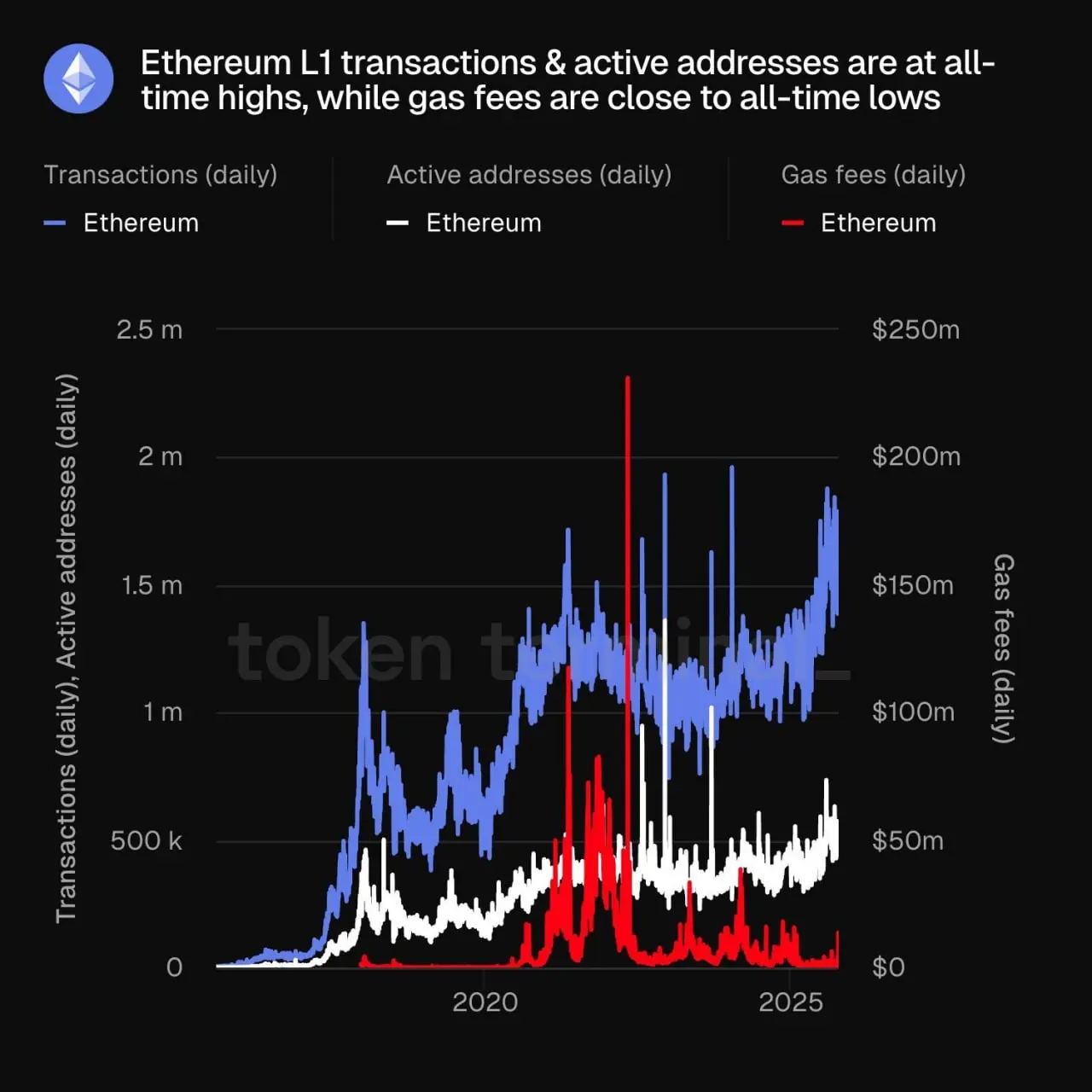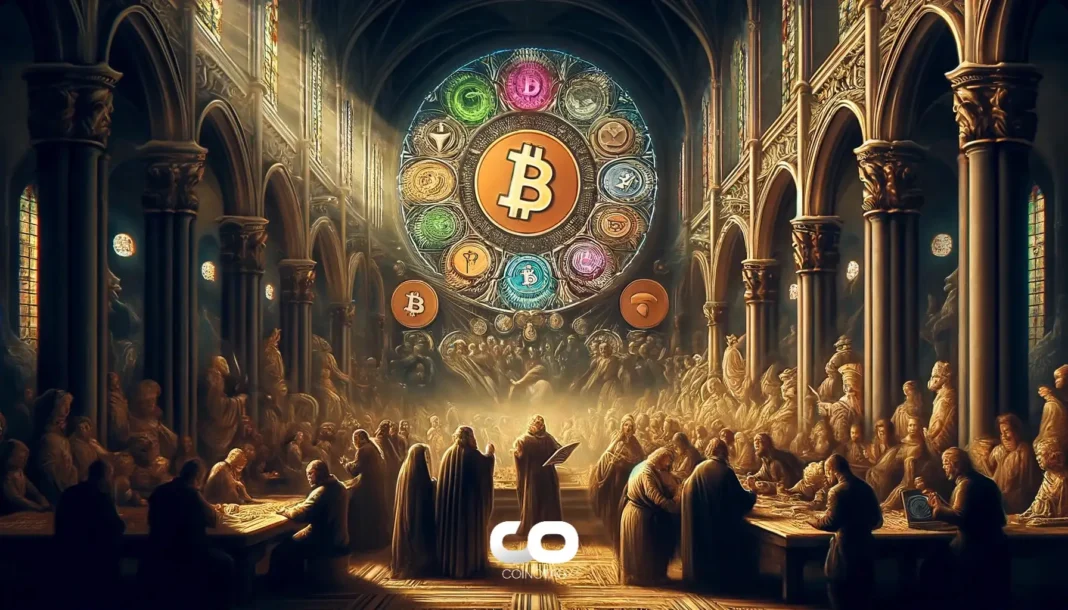Ethereum on-chain activity has surged with daily transactions topping 2 million and active addresses above 1 million, while average gas fees have fallen to multi-year lows thanks to Layer 2 adoption and protocol upgrades like EIP-4844, improving scalability and lowering transaction costs for retail and institutions.
-
Daily transactions surpassed 2 million and active addresses exceeded 1 million.
-
Average gas fees dropped to multi-year lows as Layer 2 rollups and EIP-4844 reduce mainnet congestion.
-
TVL has risen to ~$86.04B; DEX monthly volume exceeded $130B and transaction value hit $320B.
Ethereum on-chain activity surges with record transactions and low gas fees; read the latest on network growth, TVL, and institutional accumulation—COINOTAG deep dive.
What is driving Ethereum’s recent on-chain activity?
Ethereum on-chain activity has increased due to broader Layer 2 adoption, renewed retail engagement, and large-scale institutional accumulation. Daily transactions and active addresses have reached multi-year highs while improvements such as EIP-4844 and rollup deployments lowered fees, enabling higher throughput and more cost-effective DeFi use.
How have Ethereum gas fees fallen to record lows?
Fee declines stem from multiple, measurable changes. Layer 2 rollups like Arbitrum, Optimism and Base have moved volume off-chain for cheaper settlement. Protocol-level upgrades—most notably EIP-4844 (Proto-Danksharding)—have improved data availability and reduced mainnet pressure. Token Terminal and DeFiLlama cite daily transactions above 2 million and monthly DEX volume past $130 billion, while average daily gas-related costs decreased from >$200M in 2021 to roughly $10–20M recently. These factors combined have lowered per-transaction costs and enabled smaller users to return to DeFi apps and NFT marketplaces.
Institutional flows also play a role. Public data from Strategic Eth Reserve identifies BitMine holding roughly 3.03 million ETH, and SharpLink adding 39,000 ETH to reach ~838.73K ETH, indicating steady accumulation by large entities. CoinMarketCap price snapshots showed Ether near $3,974.41 at the time of reporting, with market-cap metrics reflecting ongoing liquidity and trading activity.
A surge in retail usage is visible in on-chain metrics: smart contract creation in 2025 has expanded, driven predominantly by DeFi protocols rather than NFT or meme-token launches. This pattern suggests practical utility is powering much of the renewed activity.
 Ethereum’s current market activity levels. Source: Token Terminal
Ethereum’s current market activity levels. Source: Token TerminalOn liquidity, Ethereum’s total value locked (TVL) moved to about $86.04 billion, approaching the 2021 peak of $108.8 billion. Network transaction value reached $320 billion in the same reporting window, marking one of the largest months for on-chain value transfer. DeFiLlama and Token Terminal figures underpin these topline metrics as reported by market trackers and industry observers.
Operationally, the combination of cheaper transactions and higher throughput has re-enabled smaller-value transfers—USDT and USDC transfers rank among the top smart contract interactions—restoring activity that had been constrained during periods of elevated gas prices. That shift has reintroduced a broader user base to the ecosystem while institutions continue strategic accumulation.
Frequently Asked Questions
How sustainable is the current increase in Ethereum on-chain activity over the next 12 months?
Current growth is supported by structural upgrades and Layer 2 capacity, making it sustainable if rollup adoption continues and developers migrate production workloads. Macro conditions and regulatory developments remain variables. Data from Token Terminal and DeFiLlama show elevated usage, but continued protocol improvements are needed to maintain low fees and high throughput.
Why are gas fees so low now—should I expect them to spike again?
Fees are low due to widespread rollup use and EIP-4844 implementation reducing on-chain data costs. Spikes can occur if L2s saturate or a high-demand event hits mainnet. Monitoring rollup capacity and on-chain congestion metrics helps anticipate short-term volatility in gas prices.
Key Takeaways
- Network usage is at multi-year highs: Daily transactions surpassing 2 million and active addresses above 1 million indicate resumed mass activity.
- Fees have materially declined: Layer 2 rollups and EIP-4844 reduced average daily gas costs from 2021 peaks to roughly $10–20M per day.
- Institutional and retail trends align: Large holders (e.g., BitMine, SharpLink) continue accumulating while retail returns to DeFi, increasing TVL and trading volumes.
Conclusion
Ethereum’s recent surge in on-chain activity—driven by Layer 2 adoption, protocol upgrades like EIP-4844, and renewed retail and institutional participation—has produced record transactions and significantly lower gas fees. These developments suggest a more scalable and accessible Ethereum ecosystem in the near term; stakeholders should monitor Layer 2 capacity and network metrics for the next growth phase.
Published: 14 October 2025. Updated: 14 October 2025. Author/Organization: COINOTAG. Data sources referenced as plain text: Token Terminal, DeFiLlama, Strategic Eth Reserve, CoinMarketCap, and Cryptopolitan.






